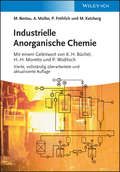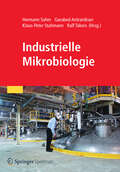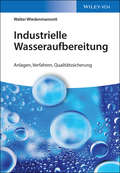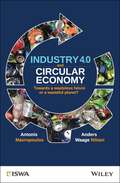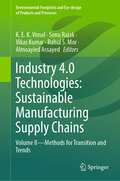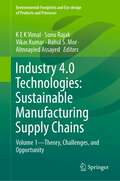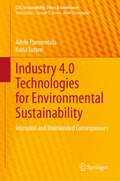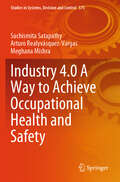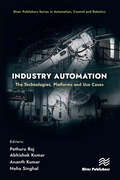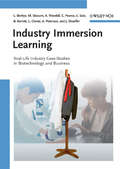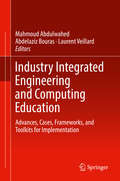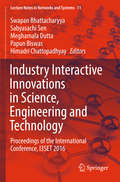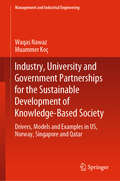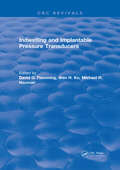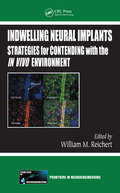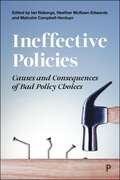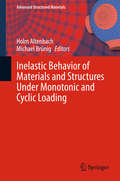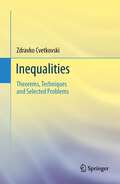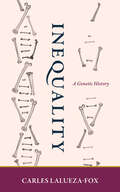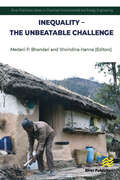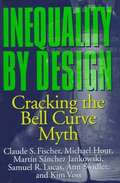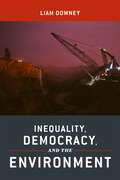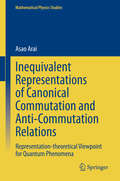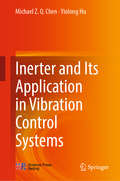- Table View
- List View
Industrielle Anorganische Chemie
by Martin Bertau Armin Müller Peter Fröhlich Michael Katzberg Karl Heinz Büchel Hans-Heinrich Moretto Dietmar WernerMit einem neuen Herausgeberteam wird das Buch "Industrielle Anorganische Chemie" grundlegend überarbeitet weitergeführt. Das Lehrwerk bietet in hervorragend übersichtlicher, knapp und präzise gehaltener Form eine aktuelle Bestandsaufnahme der industriellen anorganischen Chemie. Zu Herstellungsverfahren, wirtschaftlicher Bedeutung und Verwendung der Produkte, sowie zu ökologischen Konsequenzen, Energie- und Rohstoffve brauch bieten die Autoren einen fundierten Überblick. Hierfür werden die bewährten Prinzipien hinsichtlich der Beiträge von Vertretern aus der Industrie sowie des generellen Aufbaus beibehalten. Inhaltlich werden Neugewichtungen vorgenommen: l Aufnahme hochaktueller Themen wie Lithium und seine Verbindungen und Seltenerdmetalle l Aufnahme bislang vernachlässigter Themen wie technische Gase, Halbleiter- und Elektronikmaterialien, Hochofenprozess sowie Edelmetalle l Straffung aus industriell-anorganischer Sicht weniger relevanter Themen z.B. in den Bereichen Baustoffe oder Kernbrennstoffe l Ergänzungen in der Systematik hinsichtlich bislang nicht behandelter Alkali- und Erdalkalimetalle und ihre Bedeutung in der industriellen anorganischen Chemie l Betrachtung der jeweiligen Rohstoffsituation Begleitmaterial für Dozenten verfügbar unter: www.wiley-vch.de/textbooks "Von den Praktikern der industriellen Chemie verfasst, füllt dieser Band eine Lücke im Fachbuchangebot. Das Buch sollte von jedem fortgeschrittenen Chemiestudenten und auch von Studierenden an Fachhochschulen technischchemischer Richtungen gelesen werden. Dem in der Industrie tätigen Chemiker schließlich bietet es einen lohnenden Blick über den Zaun seines engen Arbeitsgebietes.... Die Autoren haben ein Buch vorgelegt, dem man eine weite Verbreitung wünschen und vorhersagen kann." GIT "Das Buch kann uneingeschränkt empfohlen werden." Nachrichten aus Chemie Technik und Laboratorium "sein besonderer Wert liegt in der anschaulichen Darstellung und in der Verknüpfung technischer und wirtschaftlicher Fakten." chemie-anlagen + verfahren
Industrielle Mikrobiologie
by Hermann Sahm, Garabed Antranikian, Klaus-Peter Stahmann and Ralf TakorsDie Industrielle Mikrobiologie vereint das Fachwissen von Naturwissenschaftlern und Ingenieuren über die Nutzung von Bakterien und Pilzen. Als innovative Querschnittsdisziplin bietet sie wichtige Voraussetzungen für die Entwicklung konkurrenzfähiger Produkte auf der Basis umweltschonender Verfahren. So setzt z.B. die chemische Industrie heute bereits Mikroorganismen in Prozessen ein, um Rohstoffe und Energie sparen. In dieser Branche besteht ein zunehmender Bedarf an gut ausgebildeten Fachkräften.Dieses neue Lehrbuch wurde von erfahrenen Wissenschaftlern aus Hochschulen und der Industrie verfasst. Es soll Studierende aus Life Science-Bachelorstudiengängen sowie fortgeschrittene Studierende der Chemie oder der Ingenieurwissenschaften in die Industrielle Mikrobiologie einführen. Es vermittelt die Grundlagen der Entwicklung von Produktionsstämmen und erklärt spezielle Verfahren zur Herstellung mikrobieller Produkte. Dabei wird aufgezeigt, wie das Potential der Mikroorganismen optimal genutzt werden kann.Zunächst wird ein Überblick über die geschichtliche Entwicklung der Industrielle Mikrobiologie und eine Einführung in die Bioverfahrenstechnik gegeben. Anschließend werden in 10 Kapiteln ausgewählte mikrobielle Verfahren zur Herstellung von Lebensmitteln, organischen Säuren, Alkoholen, Aminosäuren, Vitaminen, Antibiotika, Pharmaproteinen, Enzymen, Biopolymeren sowie Steroiden und Aromastoffen beschrieben. Im letzten Kapitel wird am Beispiel der biologischen Abwasserreinigung aufgezeigt, dass die Mikroorganismen nicht nur ein enormes Synthese-, sondern auch ein großes Abbaupotential besitzen, mit dem sie einen Beitrag zu den Stoffwechselkreisläufen auf unserer Erde leisten.Die Autoren wünschen sich, dass dieses Lehrbuch das Interesse vieler Studierender an diesem spannenden Lehr- und Forschungsgebiet weckt und sie daraus Nutzen ziehen können, um dann selbst zur weiteren Entwicklung der Industriellen Mikrobiologie beizutragen.
Industrielle Mikrobiologie
by Klaus-Peter Stahmann Garabed Antranikian Ralf Takors Hermann SahmDie Industrielle Mikrobiologie vereint das Fachwissen von Naturwissenschaftlern und Ingenieuren über die Nutzung von Bakterien und Pilzen. Als innovative Querschnittsdisziplin bietet sie wichtige Voraussetzungen für die Entwicklung konkurrenzfähiger Produkte auf der Basis umweltschonender Verfahren. So setzt z.B. die chemische Industrie heute bereits Mikroorganismen in Prozessen ein, um Rohstoffe und Energie sparen. In dieser Branche besteht ein zunehmender Bedarf an gut ausgebildeten Fachkräften. Dieses neue Lehrbuch wurde von erfahrenen Wissenschaftlern aus Hochschulen und der Industrie verfasst. Es soll Studierende aus Life Science-Bachelorstudiengängen sowie fortgeschrittene Studierende der Chemie oder der Ingenieurwissenschaften in die Industrielle Mikrobiologie einführen. Es vermittelt die Grundlagen der Entwicklung von Produktionsstämmen und erklärt spezielle Verfahren zur Herstellung mikrobieller Produkte. Dabei wird aufgezeigt, wie das Potential der Mikroorganismen optimal genutzt werden kann. Zunächst wird ein Überblick über die geschichtliche Entwicklung der Industrielle Mikrobiologie und eine Einführung in die Bioverfahrenstechnik gegeben. Anschließend werden in 10 Kapiteln ausgewählte mikrobielle Verfahren zur Herstellung von Lebensmitteln, organischen Säuren, Alkoholen, Aminosäuren, Vitaminen, Antibiotika, Pharmaproteinen, Enzymen, Biopolymeren sowie Steroiden und Aromastoffen beschrieben. Im letzten Kapitel wird am Beispiel der biologischen Abwasserreinigung aufgezeigt, dass die Mikroorganismen nicht nur ein enormes Synthese-, sondern auch ein großes Abbaupotential besitzen, mit dem sie einen Beitrag zu den Stoffwechselkreisläufen auf unserer Erde leisten. Die Autoren wünschen sich, dass dieses Lehrbuch das Interesse vieler Studierender an diesem spannenden Lehr- und Forschungsgebiet weckt und sie daraus Nutzen ziehen können, um dann selbst zur weiteren Entwicklung der Industriellen Mikrobiologie beizutragen.
Industrielle Wasseraufbereitung: Anlagen, Verfahren, Qualitätssicherung
by Walter WiedenmannottWasser ist ein wichtiger Rohstoff für viele Industriezweige. Eine stabile und kontrollierte Wasserqualität ist eine entscheidende Voraussetzung für die Herstellung von Pharmazeutika, Medizinprodukten, Nahrungsmitteln und Kosmetika. Dieses Praxishandbuch für Anwender im Betrieb gibt einen Überblick über die relevanten Daten, Fakten und Bestimmungen für den Umgang mit Wasser in der industriellen Produktion, von der Auslegung der Komponenten bis zur Inbetriebnahme, einschließlich der Zertifizierung und Überwachung der Anlagen im laufenden Betrieb. Nach einer allgemeinen Einführung in die Grundlagen der Wasserchemie und Wassertechnologie stellt der Autor die im industriellen Umfeld üblichen Verfahren und Anlagen zur Wasseraufbereitung vor, von der mechanischen über die thermische bis hin zur chemischen Aufbereitung. Eingehend werden die besonderen Qualitätsanforderungen und Verfahren für hochreine Wässer wie Kesselspeisewasser und Pharmawasser beschrieben. Der letzte Teil des Buches widmet sich der Kontrolle und Vermeidung von mikrobiellen Verunreinigungen, die für viele Anwendungen das größte Problem für die Wasserqualität darstellen.
Industry 4.0 and Circular Economy: Towards a Wasteless Future or a Wasteful Planet? (International Solid Waste Association)
by Antonis Mavropoulos Anders Waage NilsenHow the marriage of Industry 4.0 and the Circular Economy can radically transform waste management—and our world Do we really have to make a choice between a wasteless and nonproductive world or a wasteful and ultimately self-destructive one? Futurist and world-renowned waste management scientist Antonis Mavropoulos and sustainable business developer and digital strategist Anders Nilsen respond with a ringing and optimistic “No!” They explore the Earth-changing potential of a happy (and wasteless) marriage between Industry 4.0 and a Circular Economy that could—with properly reshaped waste management practices—deliver transformative environmental, health, and societal benefits. This book is about the possibility of a brand-new world and the challenges to achieve it. The fourth industrial revolution has given us innovations including robotics, artificial intelligence, 3D-printing, and biotech. By using these technologies to advance the Circular Economy—where industry produces more durable materials and runs on its own byproducts—the waste management industry will become a central element of a more sustainable world and can ensure its own, but well beyond business as usual, future. Mavropoulos and Nilsen look at how this can be achieved—a wasteless world will require more waste management—and examine obstacles and opportunities such as demographics, urbanization, global warming, and the environmental strain caused by the rise of the global middle class. · Explore the new prevention, reduction, and elimination methods transforming waste management · Comprehend and capitalize on the business implications for the sector · Understand the theory via practical examples and case studies · Appreciate the social benefits of the new approach Waste-management has always been vital for the protection of health and the environment. Now it can become a crucial role model in showing how Industry 4.0 and the Circular Economy can converge to ensure flourishing, sustainable—and much brighter—future.
Industry 4.0 Technologies: Volume II - Methods for transition and trends (Environmental Footprints and Eco-design of Products and Processes)
by K. E. K. Vimal Sonu Rajak Vikas Kumar Rahul S. Mor Almoayied AssayedThis book covers topics related to implementation of advanced technologies, such as AI, big data, procurement 4.0, Logistics 4.0 and Lean 4.0, in Industry 4.0 for the manufacturing supply chain. Many applications of Industry 4.0 in the manufacturing supply chain have been presented. The content of this book is useful for students, researchers and professionals in order to implement Industry 4.0 in manufacturing supply chain.
Industry 4.0 Technologies: Volume 1—Theory, Challenges, and Opportunity (Environmental Footprints and Eco-design of Products and Processes)
by K E K Vimal Sonu Rajak Vikas Kumar Rahul S. Mor Almoayied AssayedThis book brings forth the fundamental understanding of the role of Industry 4.0 technologies in sustainable manufacturing supply chain. Readers will get an overview of the challenges, opportunities, and requirements for the implementation of digital technologies and how they can support manufacturing supply chains to be sustainable. The book presents many applications of Industry 4.0 including integration of IoT, AI, Big Data, Blockchain, Procurement 4.0, Logistics 4.0, and Lean 4.0 in different contexts. The book therefore provides a platform for researchers, academicians, and professionals from diverse backgrounds to gain state-of-the-art knowledge for using Industry 4.0 in sustainable manufacturing supply chains. Readers will also be able to identify the practical significance and opportunities for future work directions.
Industry 4.0 Technologies for Environmental Sustainability: Intended and Unintended Consequences (CSR, Sustainability, Ethics & Governance)
by Adele Parmentola Ilaria TutoreIndustry 4.0 technologies are expected to have a positive impact on the global economy by promoting autonomous interoperability, agility, flexibility, decision-making, efficiency or cost reduction, which are also expected to be resource efficient. However, new and emerging technologies can also have potentially harmful social and environmental impacts that must be considered.The goal of this book is to provide a deeper understanding of how Industry 4.0 technologies can benefit or harm the environmental sustainability of companies. To this end, it presents a classification of Industry 4.0 technologies and evaluates for each typology the positive and negative aspects of their implementation. Thus, the book considers Industry 4.0 technology and environmental sustainability from the perspective of management on the one hand and from the perspective of technology users on the other. The book is of interest to researchers from various disciplines who approach Industry 4.0 technologies from a business perspective, and on the other hand to managers and strategic consultants who want to promote sustainable change in their companies.
Industry 4.0 A Way to Achieve Occupational Health and Safety (Studies in Systems, Decision and Control #575)
by Suchismita Satapathy Arturo Realyvásquez-Vargas Meghana MishraThis book consists of advances in data intelligence and its applications in sustainable computing and explores challenges of Industry 4.0. Occupational health and safety is a problem faced by many industries. It effects health, safety, and also wellbeing of employees and workers engaged. Industry 4.0 has changed the total scenario of many industries. Safety and sustainability are two major problems with most industries and other emerging sectors. So, safety is a most important criterion and is often taken care of by framing and following safety policies. Soft computing methods are used to resolve all innovative and research problems in engineering, manufacturing, and business management areas. Much innovative design and sustainable solutions are resolved by IoT and AI techniques. Any troublesome work without hard labor and with easy approaches can be resolved by IoT, which is safer and can be learned quickly. It will help research and find a significant replacement with innovative solutions to any technical and business-related problems. A huge and developing number of producers acknowledge generous monetary and natural advantages from feasible strategic policies. Manageable assembling makes items through financially strong cycles that limit adverse ecological effects while moderating energy and regular assets. Sustainable manufacturing also enhances employee, community, and product safety. A developing number of organizations are treating sustainability as a significant goal in their procedure and activities to build development and worldwide intensity practices in every place of manufacturing industries. Automation systems usually make workplaces safer by keeping people out of dangerous situations. They also encourage inclusion by substituting less physically demanding computer-based monitoring activities with jobs requiring strength or agility. The shift from a physically oriented to a knowledge-based work environment substitutes more intellectual, decentralised decision-making stresses for workplace problems like repeated actions.
Industry Automation: The Technologies, Platforms and Use Cases (River Publishers Series in Automation, Control and Robotics)
by Pethuru Raj Abhishek Kumar Ananth Kumar Neha SinghalThis book details cutting-edge technologies, versatile tools, adaptive processes, integrated platforms, and best practices of digitized systems. With the faster maturity and stability of digitization and digitalization technologies, all kinds of physical, mechanical, and electrical systems in our everyday environments (homes, hotels, hospitals, manufacturing floors, etc.) have become digitized systems. Such technology has empowered systems to gain the power to join and contribute to fulfilling the goals of modern computing. Such digitized entities assist in producing and deploying hugely complicated yet sophisticated context-aware services and applications. The other principal contribution is capturing environmental data in real time and enabling local data processing to bring forth actionable insights. This facilitates insight-driven decisions and deeds. Precisely speaking, the aspects of real-time knowledge discovery and dissemination enable the creation and delivery of real-time and real-world features and functionalities.All industrial artifacts are being digitized, connected and empowered to be cognitive in their operations, offerings and outputs. By smartly leveraging a dazzling array of digital technologies and tools, the interaction and collaboration with human experts becomes hugely simplified and speeded up considerably. Such cognition-enabled industrial machineries, equipment, appliances, assembly lines, robots, vehicles, drones, and other assets collectively provide an intelligent environment to envisage and realize state-of-the-art industry 4.0 and 5.0 applications. Every industrial process gets optimized and automated to produce next-generation products to ensure customer delight, to explore fresh avenues to enhance revenues and to embark on higher productivity.In addition, there are chapters illustrating industrial use cases, infrastructure optimization, technology assimilation, and AI-powered data analytics towards industry automation.
Industry Immersion Learning: Real-Life Industry Case-Studies in Biotechnology and Business
by William Barrett Lucia Clontz Cedric Pearce Alan Woodall John Shaeffer Lisbeth Borbye Amy Peterson Elaine Sale Michael StocumHow to Create and Conduct Real-Life Reusable Case Studies with Industry Employer Alliances and Projects Written and Endorsed by Science and Business Professionals in the Research Triangle Park in North Carolina, USA. Many students and university teachers are unfamiliar with the industry environment. Case studies developed in collaboration with working professionals can help students and professors bridge the gap between universities and industry. This book provides guidance on how to approach industry professionals and create educational alliances. The strategy of establishing contact with industry employers and the process of developing and teaching case-studies are described. Among the case-studies are examples of how to identify biomarkers and new drugs simultaneously, prioritize and develop products in compliance with rules and regulations, commercialize products and protect and manage the intellectual property, optimize processes and technologies for manufacturing, and minimize human errors in production.
Industry Integrated Engineering and Computing Education: Advances, Cases, Frameworks, and Toolkits for Implementation
by Mahmoud Abdulwahed Abdelaziz Bouras Laurent VeillardThis book introduces recent global advances and innovations in industry integrated engineering and computing education to academics, program managers, department heads, and deans, and shares with readers a critical perspective on future potentials in industry integrated engineering education. It covers topics and issues such as integrated engineering and computing education, part-time engineering masters programs, secure BIM learning, ethics, and IT workforce development. The book concludes with detail information on summarizing and extracting different frameworks, cases, and models into a practitioner toolkit, along with pragmatic recommendations for engineering education academics to quickly utilize, adopt, and adapt the toolkits for their own curricular development activities.
Industry Interactive Innovations in Science, Engineering and Technology
by Swapan Bhattacharyya Sabyasachi Sen Meghamala Dutta Papun Biswas Himadri ChattopadhyayThe book is a collection of peer-reviewed scientific papers submitted by active researchers in the International Conference on Industry Interactive Innovation in Science, Engineering and Technology (I3SET 2016). The conference is a collective initiative of all departments and disciplines of JIS College of Engineering (an autonomous institution), Kalyani, West Bengal, India. The primary objective of the conference is to strengthen interdisciplinary research and encourage innovation in a demand-driven way as desired by the industry for escalating technology for mankind. A galaxy of academicians, professionals, scientists, industry people and researchers from different parts of the country and abroad shared and contributed their knowledge. The major areas of I3SET 2016 include nonconventional energy and advanced power systems; nanotechnology and applications; pattern recognition and machine intelligence; digital signal and image processing; modern instrumentation, control, robotics and automation; civil engineering and structural design; real-time and embedded systems, communication and devices; advanced optimization techniques; biotechnology, biomedical instrumentation and bioinformatics; and outcome based education.
Industry, University and Government Partnerships for the Sustainable Development of Knowledge-Based Society: Drivers, Models and Examples in US, Norway, Singapore and Qatar (Management and Industrial Engineering)
by Waqas Nawaz Muammer KoçThis book discusses the rapidly growing interest in economic diversification through partnerships between industry, university and government (IUGP), with a focus on the economic diversification of the state of Qatar. It provides a comparative account of the knowledge ecosystem in the USA, Norway, Singapore and Qatar, and offers an evolutionary, national economic-transformational perspective on legislation, institutional and cultural settings, intermediary structures, and support programs. Providing a broad overview of the knowledge ecosystems in these countries, it is suitable for readers at various learning levels. It also includes case studies and a concise comparison of the Global Innovation Index (GII) of the four countries, and explores in detail the under-par comparative performance of Qatar, revealing that the country is still at the engagement level of IUGP. Further, it proposes evidence-based recommendations and strategies, making it a valuable resource for researchers, graduate students and policymakers.
Indwelling and Implantable Pressure Transducers
by D.G. FlemmingIn the first two chapters of this book there is information about the needs and potential applications of indwelling transducers both present and past, and will go into detail about many topics such as the fundaments of blood pressure transducers, studies of the intestinal motility and clinical aspects of cardiovascular pressure measurements. Chapters 3, 4 & 5 explain and give information on manufacturers considerations of indwelling pressure transducer, specifications of commercial pressure transducers. Research and development of indwelling pressure transducer, explaining the principles of pressure transducer, biomedical applications. And then they move onto future directions for implant pressure transducers and the users point of view. This book covers a wide spectrum on indwelling pressure transducers.
Indwelling Neural Implants: Strategies for Contending with the In Vivo Environment
by William M. ReichertDespite enormous advances made in the development of external effector prosthetics over the last quarter century, significant questions remain, especially those concerning signal degradation that occurs with chronically implanted neuroelectrodes. Offering contributions from pioneering researchers in neuroprosthetics and tissue repair, Indwel
Ineffective Policies: Causes and Consequences of Bad Policy Choices
by Ian Roberge, Heather McKeen-Edwards, and Malcolm Campbell-VerduynAvailable open access digitally under CC-BY-NC-ND licence. Bad policies have repercussions that can be felt for decades. But what makes a bad policy? And how can it be reversed or improved? Bringing together scholars from Europe and North America, this book goes beyond traditional policy theory to study bad and ineffective policies across three fields: • the environment; • the financial services sector; and • emerging technologies. Using cutting-edge research and analysis, the editors and authors state the case for studying ineffective policies, demonstrate their harmful effects across policy fields and provide policy makers with the tools to reflect, identify, and act upon them.
Inelastic Behavior of Materials and Structures Under Monotonic and Cyclic Loading
by Holm Altenbach Michael BrünigThis book presents studies on the inelastic behavior of materials and structures under monotonic and cyclic loads. It focuses on the description of new effects like purely thermal cycles or cases of non-trivial damages. The various models are based on different approaches and methods and scaling aspects are taken into account. In addition to purely phenomenological models, the book also presents mechanisms-based approaches. It includes contributions written by leading authors from a host of different countries.
Inequalities
by Zdravko CvetkovskiThis work is about inequalities which play an important role in mathematical Olympiads. It contains 175 solved problems in the form of exercises and, in addition, 310 solved problems. The book also covers the theoretical background of the most important theorems and techniques required for solving inequalities. It is written for all middle and high-school students, as well as for graduate and undergraduate students. School teachers and trainers for mathematical competitions will also gain benefit from this book.
Inequality: A Genetic History
by Carles Lalueza-FoxHow genomics reveals deep histories of inequality, going back many thousands of years. Inequality is an urgent global concern, with pundits, politicians, academics, and best-selling books all taking up its causes and consequences. In Inequality, Carles Lalueza-Fox offers an entirely new perspective on the subject, examining the genetic marks left by inequality on humans throughout history. Lalueza-Fox describes genetic studies, made possible by novel DNA sequencing technologies, that reveal layers of inequality in past societies, manifested in patterns of migration, social structures, and funerary practices. Through their DNA, ancient skeletons have much to tell us, yielding anonymous stories of inequality, bias, and suffering. Lalueza-Fox, a leader in paleogenomics, offers the deep history of inequality. He explores the ancestral shifts associated with migration and describes the gender bias unearthed in these migrations—the brutal sexual asymmetries, for example, between male European explorers and the women of Latin America that are revealed by DNA analysis. He considers social structures, and the evidence that high social standing was inherited—the ancient world was not a meritocracy. He untangles social and genetic factors to consider whether wealth is an advantage in reproduction, showing why we are more likely to be descended from a king than a peasant. And he explores the effects of ancient inequality on the human gene pool. Marshaling a range of evidence, Lalueza-Fox shows that understanding past inequalities is key to understanding present ones.
Inequality – the unbeatable challenge
by Medani P. Bhandari Shvindina HannaThis edited book presents some unexplored issues of economic inequality, including case studies of various countries. Inequality is a chronic and divisive factor of society. Inequality exists as an integral attribute of human development. Communities, nations, and systems are not evolving at the same speed and rate and thus require different resources in different amounts. However, the distribution of winnings is also uneven due to the multidimensionality of influencing factors.When we talk about inequality, it is not just inequality of income or wealth; it is first, inequality in access to priorities and human needs – to shelter, to clean water, air, health care, and also to appropriate vaccination systems and assistance, security systems and safety guarantees for the future. Past financial crises and the current pandemic shock has revealed bugs in the system, shaking it and changing our perception of the norms.We may have no doubts that inequality is an unsolved problem, but now we need to find out - is it unbeatable? There is still lack of knowledge around how inequality has been grounded throughout human civilization, why society is stratified and classified, economically, politically, socially, and religiously; and why the discrimination due to gender, sexual orientation, country of origin, language differences, immigration status, caste, race and ethnicity? This book addresses these issues in a holistic way as well as including case studies of various countries. It tries to find out why inequality has been unbeatable and what would be the best policies to overcome this challenge.
Inequality by Design: Cracking the Bell Curve Myth
by Claude S. Fischer"Inequality by Design's most important findings describe an America deeply stratified by class, an America in which equal opportunity remains only and idle dream...[It] may well after the public discussion...with a shot across the bow of the nation's policymakers."--Lingua Franca "One of the most important books on what divides America socially and economically since the work of Christopher Jencks and his Harvard colleagues nearly a quarter century ago."--Daniel Bell
Inequality, Democracy, and the Environment
by Liam DowneyWinner, American Sociological Association Section on Environment and Technology Allan Schnaiberg Outstanding Publication AwardThe world currently faces several severe social and environmental crises, including economic under-development, widespread poverty and hunger, lack of safe drinking water for one-sixth of the world’s population, deforestation, rapidly increasing levels of pollution and waste, dramatic declines in soil fertility and biodiversity, and global warming. Inequality, Democracy, and the Environment sheds light on the structural causes of these and other social and environmental crises, highlighting in particular the key role that elite-controlled organizations, institutions, and networks play in creating these crises. Liam Downey focuses on four topics—globalization, agriculture, mining, and U.S. energy and military policy—to show how organizational and institutional inequality and elite-controlled organizational networks produce environmental degradation and social harm. He focuses on key institutions like the World Bank, the International Monetary Fund, the U.S. Military and the World Trade Organization to show how specific policies are conceived and enacted in order to further elite goals. Ultimately, Downey lays out a path for environmental social scientists and environmentalists to better understand and help solve the world’s myriad social and environmental crises. Inequality, Democracy and the Environment presents a passionate exposé of the true role inequality, undemocratic institutions and organizational power play in harming people and the environment.
Inequivalent Representations of Canonical Commutation and Anti-Commutation Relations: Representation-theoretical Viewpoint for Quantum Phenomena (Mathematical Physics Studies)
by Asao AraiCanonical commutation relations (CCR) and canonical anti-commutation relations (CAR) are basic principles in quantum physics including both quantum mechanics with finite degrees of freedom and quantum field theory. From a structural viewpoint, quantum physics can be primarily understood as Hilbert space representations of CCR or CAR. There are many interesting physical phenomena which can be more clearly understood from a representation–theoretical viewpoint with CCR or CAR. This book provides an introduction to representation theories of CCR and CAR in view of quantum physics. Particular emphases are put on the importance of inequivalent representations of CCR or CAR, which may be related to characteristic physical phenomena. The topics presented include general theories of representations of CCR and CAR with finite and infinite degrees of freedom, the Aharonov–Bohm effect, time operators, quantum field theories based on Fock spaces, Bogoliubov transformations, and relations of infinite renormalizations with inequivalent representations of CCR. This book can be used as a text for an advanced topics course in mathematical physics or mathematics.
Inerter and Its Application in Vibration Control Systems
by Michael Z. Chen Yinlong HuThis book offers the first comprehensive introduction to the inerter, its successful application in Formula One racing, and other state-of-the-art applications in vibration control. It presents fundamental analysis results and design methods for inerter-based vibration control systems. Providing comprehensive information on the inerter, a pioneering mechanical element invented by Prof. Malcolm C. Smith at Cambridge University in 2002, it will be of considerable interest to readers with a background in control theory, mechanical vibration or related subjects.
